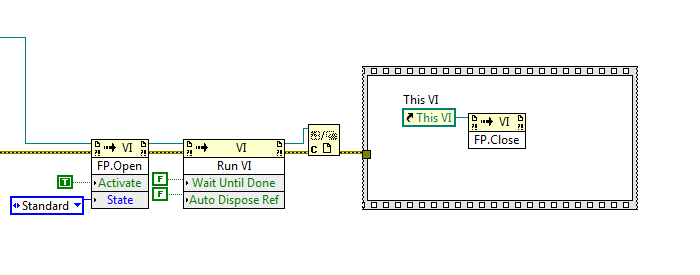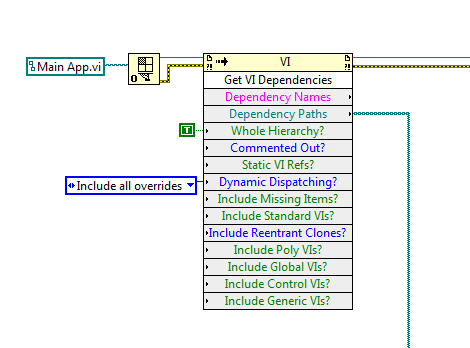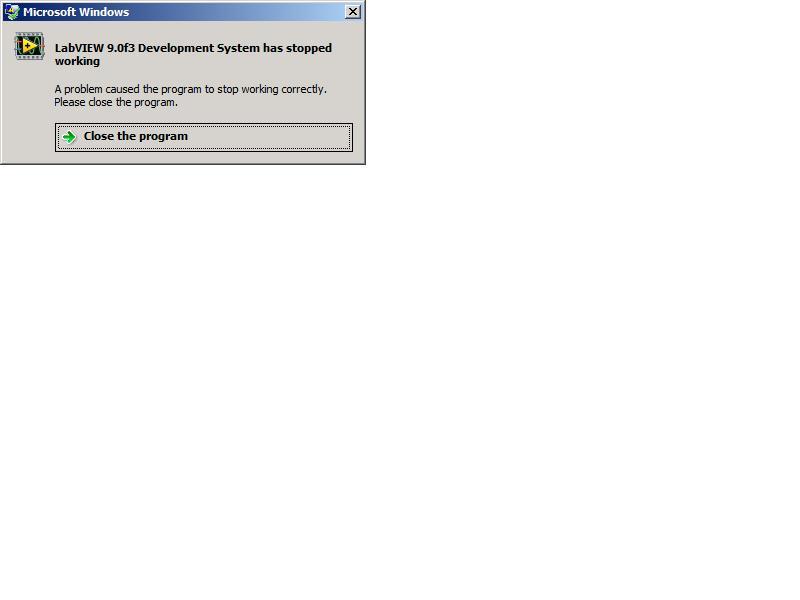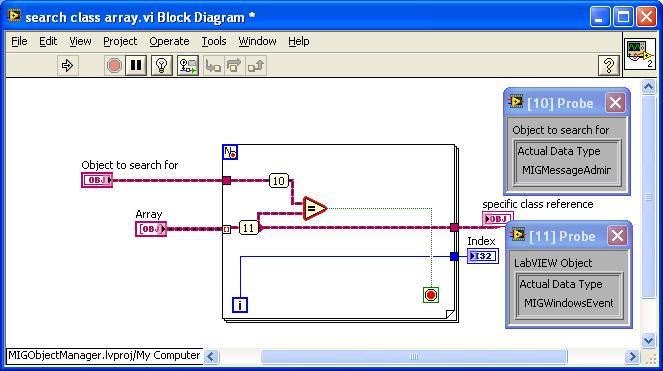
Rammer
Members-
Posts
27 -
Joined
-
Last visited
Content Type
Profiles
Forums
Downloads
Gallery
Everything posted by Rammer
-
Does anyone know if GOOP V4.2 is compatible with LabVIEW 2012? We have problems with LabVIEW 2012 crashing on 8 computers. Only difference between them and the one computer that works is GOOP. John
-
Thanks Mikael, Any chance a future converter will be able to do this automatically?
-
Mikail, I have used the converter. One question: In true GOOP4 class structures I gain access to the parent class attributes by calling the get attributes of the parent within the child. I noticed that when I converted the objectattributes.ctl of the converted (GOOP4 class) has the attributes of the base still in it. Should I access the base through these or through the get attributes of the base class? Should I delete these controls from the object attributes control? John
-
Aristos, Can you post your example soon than in August? Any comments on the property that I am using to get the dependencies? Is it valid? Rammer
-
Wow, sorry didn't mean to generate so much chatter. I like the concept of the VI Server Splash Screen. It is easy to communicate back and forth using notifiers and message queues but if you have a large main application it seems most of the start up time is loading into memory. This leads me to two comments: 1. It would be nice to show this loading progress. This seems to be bit of a mystery. As Aristos pointed out as soon as I open the reference I see most the VI's in memory using Digging in more I found: So I thought, could I setup a progress bar to make sure all the main application dependencies are loaded by first checking against the loaded VI’s and if not there open a reference to it: Then show the main VI: This seems to pseudo work in that the splash comes up right away and the user is not left waiting and wondering what is going on. But: 2. The build process is much more complicated. If I want to keep my splash main “lean” I have to tell all the dependency VI’s to be built into the support or some other directory. Since many of these VI’s are shared amongst applications it would be nice to stuff them into a central location not in the install or build path. This is very cumbersome. So if the main VI is small this is seamless, if the main VI is more complex it seems like this becomes a pain. It would also be nice if I could specify in the build to keep the hierarchy just for certain libraries – notably classes. Right now you can keep the hierarchy for particular “Destination”. Then when you create your installer you end of having to redo all the installations because it does not seem to have a concept of the “central location” if it is not in the build path.
-
Is there an easy way to tie the progress of the main application loading to a progress bar or the "fade" other than a timer? i.e. is there a way to get the progress of the VI Load while it is loading? Also, can you post your code if possible?
-
GOOP Development Suite v4.1 is released
Rammer replied to Jan Klasson's topic in Object-Oriented Programming
Is GOOP v4.1 suppose to work with LV 2011 SP1? If I run the installer it craps out on the mass compile and corrupts the entire labview installation. I have tried 4 times. Anyone gotten this to work? Thoughts why it does not? Looks like I will skip SP1. John -
I discovered that the Execution System must be the same between the parent and all children for overridden VI's. Does anyone know what happens if the descendant VI is called dynamically? Can you set the execution and thread priority through VI server? John
-
Does the licensing apply only to commercially deployed applications? If I run a test program internally to my company do I need all this EULA?
-
We are looking to distribute our code. I was wondering if people had suggestions on the best ways to generated compiled help files (chm) for a VI library. I know there are some instructions in the LV help but thought there might be an "all-in-one" tool out there or some handy hints from people that have been doing this already. Thanks for you suggestions. John
- 21 replies
-
- help
- documentation
-
(and 1 more)
Tagged with:
-
Does anyone know if Symbio plans to come up with a GOOP 3 to GOOP 4 class converter? I don't know if this is even possible with the new DVR archtecture. If not has anyone rolled their own or have any tips? We have about 75 classes we would like to convert. Without some automation this is not economically feesible for us. John
-
We just upgraded to LV 2010. Now one of our VI's does not function. It calls a custom dll with the call library function node VI. It now reports error 13. The path to the dll is correct. Does anyone have any suggestions? John
-
Mikael, I tried downloading the GOOP 4.0 LabVIEW 64 Zip file and windows keeps saying the zip file is empty. Is there an FTP site or some other way to get this? John
-
Hi Mikael, I tried downloading the beta from the link and the site was empty. Can you post a new link? John
-
Mikael, Any update on more robust support for 64 bit? John
-
It worked once. THen when LV launched a second time same error. Always works if .ini files are moved.
-
Hi Mikael, Once it starts to hang it always hangs - is there a way out or do I have to completely reinstall?
-
Has anyone used the Endevo Toolkit with LabVIEW 64 bit? LabVIEW always hangs when loading plugins and I suspect the endevo addon is the problem since it started happening more after that. Here is a picture of the error
-
Developers, I am trying to come up with a good way to display messages from an application similar to the Event Log in windows. Using a multi-column list box I can map a symbol to a bitmap of the error, warning and informational images. However, the problem I have is if I have a long message the cells do not automatically word wrap. Has anyone dealt with this? We could automatically word wrap in an Xcontrol but this seems like something that a GUI component like this should support automatically. Anyone try something like this? John
-
NI - Isn't there a way to compare the data types as equal "values"? There are many ways around the problem. Adding the string as you said works good, you just need to make sure you know the name and spell it correctly . However, there fundamentally should be a way to say give me this object by just inputing the object itself, thus using the power of true OO design.... I have not moved to 2009 yet (waiting for GOOP release to match). Has the LabVIEW Object expanded? Is there a way to get some information about an object inherently - like what it's name is or it's actual data type? Right now the only way I can see to get the class name is to use the Get LV Class Path and strip the name. -J
-
Hello, OOP developers. I am trying to develop a class that is essentially a repository for classes created in an application. Then by simply passing this single class I can gain access to any class in the application. However I am struggling. I use the Endevo GOOP for my class development. For the ObjectManager class I created an attribute that is essentially an array of LabVIEW Object classes since any and all classes derive from this class. I can successfully cast my custom classes to a more generic labVIEW Object; however searching and retrieving the specific class later becomes an issue. Below is a screen capture I take a specific class and cast it down to it's fundamental parent. With the objects being debuged I can see the actual data type of the class, however the comparison is never true. I am guessing that somehow it retains the reference data information and that is why it is not being found. Has anyone tried this? J Yes - the array does include one of the classes being searched for. The probes just show the last element of the array which is another class...
-
Mikael - How are things coming? I have not seen a 2009 version available on the Flanders web site yet? John
-
Hello all. I am trying to come up with a way to have a message table for the users of an application. I would like to show different levels of messages (Error, Warning, and Informational) and would like each to have a distinct font color in the table/array (red for error, yellow for warning, blue for informational). I have found a way to do this with a table via the property nodes. My problem is I don't want the table to grow infinitley so I limit it to the last X messages where X is usually 100. Once I hit the 100 message limit I must loop through the whole 100 cells of the table to set the new font color. This is terribly inefficient. Does anyone have any other ideas or have they done something similar? Thanks.
-
How to store pictures in a Oracle database using labview
Rammer replied to ad_dekkers's topic in Database and File IO
QUOTE (xtaldaz @ May 3 2006, 01:47 PM) I have been trying to put BLOB data into a SQL database with the parameterized query for a stored procedure. I choose the binary data type, however at some level NI must be converting to a string, because it limits me on how big this blob can be (to a very small value < 1000 data points). Has anyone overcome this?






